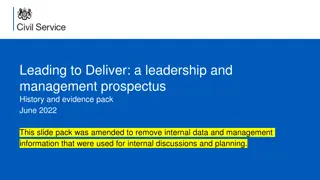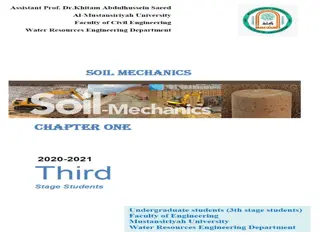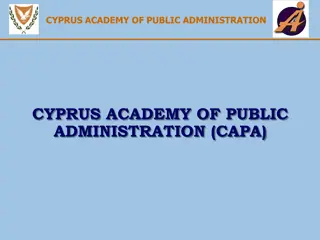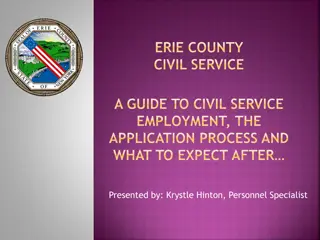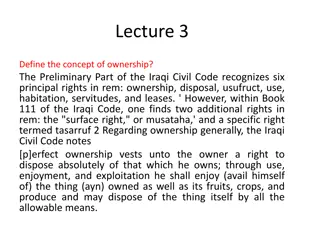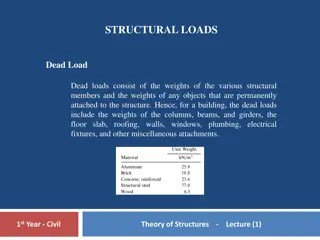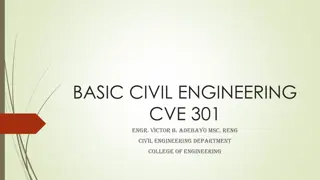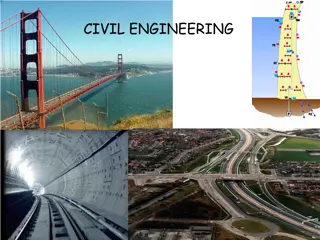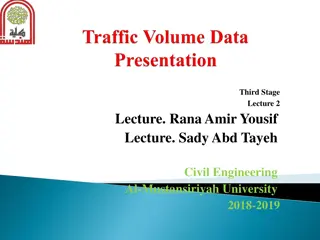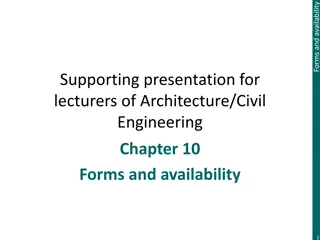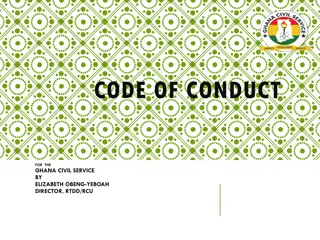Introduction to Levelling in Civil Engineering
Levelling in civil engineering involves determining relative heights of points on or below the earth's surface. This process helps in preparing contour maps, determining altitudes, preparing engineering project sections, and layout maps for various schemes. Terms used in levelling, instruments like dumpy levels, methods of levelling, and sources of errors in levelling are also discussed in this comprehensive guide.
Download Presentation

Please find below an Image/Link to download the presentation.
The content on the website is provided AS IS for your information and personal use only. It may not be sold, licensed, or shared on other websites without obtaining consent from the author. Download presentation by click this link. If you encounter any issues during the download, it is possible that the publisher has removed the file from their server.
E N D
Presentation Transcript
SARDAR PATEL INSTITUTE OF TECHNOLOGY PILUDARA SUBJECT: Elements of Civil Engineering CLASS: 1st SEM AUTOMOBILE LEVELLING
Prepared by:- 1. Axay H Shah (130680102043) 2. Mihir D Patel (130680102028) 3. Vipul Patel (130680102035) 4. Dixit Patel (130680102022) 5. Harshdeep Patel (130680102025) 6. Gaurang Patel (130680102023) Guided by :-Khushbu A. Patel
INDEX : Introduction : Definition Object Uses Terms Used In Levelling Levelling Instruments : Dumpy levels Levelling Staff Different types of Levels Methods Of Levelling Classification Of Direct Levelling Methods Special Terms And Their Abbreviation Used In Levelling Points To Be Followed By Level Man & Staff Man Steps In Levelling Levelling On a Continuously Sloping Ground Sources Of Errors In Levelling
Introduction : Definition : The art of determining the relative heights(elevation) of different points on or below the surface of the earth is known as levelling. Thus levelling deals with the measurements in the vertical plane. Object : The aim of levelling is to determine the relative heights of different points on or below the surface of the earth and to determine the undulation of the ground.
Uses Of Levelling : To prepare contour map to know the topography of the area. This map is used for fixing sites for reservoirs, bridges, culverts, and to fix the alignment of roads, railways, canals, and so on. 2. To determine the altitudes the altitudes(heights) of the different important points on a hill or to know the reduced levels of the different points with reference to datum line on or below the surface of the earth. 3. To prepare a longitudinal section (L-section) and cross- sections of a engineering project like road, railway, canal, canal, etc. in order to determine the quantity of filling or cutting of earth work. 4. To prepare a layout map for water supply, sewage treatment or drainage scheme. 1.
Terms used in levelling : Horizontal line Horizontal plane Vertical plane Vertical line Fig. Levelling Terms
A surface which is parallel to the mean spheroidal surface of the earth is called level surface, such a surface is obviously curved. The water surface of a still lake is also considered to be a level surface. It is normal to the plumb line at all the points and every point on this surface is equidistant from the centre of the earth. Level Line : The line lying on a level surface is called a level line. This line is normal to the plumb line (direction of gravity) at all points.(shown in Fig. Horizontal Plane : The plane tangential to the level surface at any point is known as the horizontal plane. It is perpendicular to the plumb line which indicates the direction of gravity. Horizontal Line : It is a line lying on the horizontal plane. It is a straight line tangential to the level line. Datum Surface or Line : Datum surface is level surface whose elevation is known as assumed. The vertical distances of different points (above or below this line) are measured from the datum surface in a vertical plane. Level Surface :
Vertical Line : It is a line perpendicular to the level surface and lies along the plumb line (the direction of gravity) through that point. Vertical Plane : A plane which is passing through the vertical line is known as the vertical plane. Reduced level (RL) : The vertical distance of a point above or below the datum surface is known as the reduced level (RL) of that point. The reduced level is used synonymously with the term elevation. Elevation : It is the vertical distance at the point above or below the datum surface. Bench Mark (BM) : The bench mark is fixed point of known RL above the datum. A point whose RL is known can be used as a bench mark. Mean Sea Level : Mean sea level is the average height of the sea for all stages of the tides. At any particular place it is derived by averaging the hourly tide heights over a long period of 19 years. The mean sea level is commonly taken as the reference level surface.
Levelling Instruments : The Instruments commonly used in leveling are: 1. A level 1. A levelling staff.
Description of Dumpy Level : Tripod Stand : The tripod stand consists of three legs which may be solid or telescopic. The legs are made of wood or aluminum. The lower ends of the Legs are fitted with iron shoes. Levelling Head : The levelling head consists of two parallel plates (trivet and tribrach) having three grooves to support the foot screws. Foot Screws : Three foot screws are provided between the trivet and tribrach. These are used for levelling. By turning the foot screws the tribrach can be raised or lowered to bring the bubble to the centre of its run. Telescope : The telescope consists of two metal tubes. One moving within inside of other. It also consists of an object glass and an eye-piece on opposite ends. A diaphagram is fixed with the telescope just in front of the eye-piece. The diaphagram carries cross-hairs. ( shown in Fig. )
Bubble Tubes : The bubble tubes are fixed on top of the telescope. Two bubble tubes are, one called the longitudinal bubble tube and other the cross-bubble tube, are placed at right angles to each others. These tubes contain spirit bubble. Compass : In some instrument compass is provided just below the telescope for measuring the magnetic bearing of a line when required. Axis OF the Telescope : This axis is an imaginary line passing through the optical centre of the object glass and the optical centre of the eye piece. Line of Collimation : It is an imaginary line passing through the intersection of the cross-hairs at the diaphragm and the optical centre of the object glass and its continuation. It is also known as the line of sight.
Levelling Staff : The levelling staff is used for measuring the vertical distances between the points on the ground and the line of collimation.
Methods of levelling : The following methods are used to determine the difference of elevation of various points. 1) Direct levelling 2) Trigonometric levelling 3) Barometric levelling 4) Hypsometric levelling The direct levelling is also known as spirit levelling. The surveyor is concerned mainly with direct levelling.
Types of leveling Staff : Self Reading : Solid Staff or Single Piece Staff : The metric solid staff is generally 3m long, 75mm wide and 25 mm thick, with a metal shoe at the bottom, and graduated on one face. The smallest division is of 5 mm in metric system. They are generally made of good quality wood of pine, devdar, etc. Telescopic staff : A telescopic staff consists of two hollow pieces and one solid top piece, each telescoping into the bottom one. When the staff is folded up, it is only a little longer than the lowest piece. When the upper sections are pulled out for use, they are engaged and held by brass spring-catches. It is thus longer than a solid staff up to 4 m to 6 m.
Continue. A folding staff is generally 4 m long and is divided into two equal parts of 2 m each. It is hinged in the middle in the middle so that top half can be folded over to lie against the lower half. Target Staff : A target staff has a sliding targeted equipped with vernier which can be clamped at any point along the staff. For taking the reading, the level man directs the staff man to raise or lower the target till it is bisected by the lime of sight. Folding Staff :
Different types of levels : The following are the different types of levels : 1) The Dumpy level 2) The Tilting Level 3) The Wye level 4) Cooke s reversible level 5) Cushing s level 6) The automatic level
Classification of direct levelling methods : Simple Levelling : This method is used for determining the difference of elevations of two points which are visible from a single position of the instrument. The level difference between any two points is determined by setting the levelling instrument midway between the points. Differential Levelling : The method is used when the two points whose difference of elevation is required are situated quite apart or when their difference of elevation is large. This method is also known as compound levelling or continuous levelling. In this method, the level is set up at several suitable positions and staff readings are taken till the last point can be sighted. ( see in Fig. )
Reciprocal Levelling : It is a method of levelling used for determining the difference of elevations of the two points which are situated on the opposite banks of a river. In reciprocal levelling the level is set up on both banks of the river or valley and two sets of staff readings are taken by holding the staff on both banks. Fly levelling : When differential levelling is done in order to connect a bench mark to the starting point of the alignment of any project ( i.e. road, railway, canal, etc.), it is called fly levelling. Fly levelling is also done to connect the BM to any intermediate point of the alignment for checking the accuracy of the work. The level should be set up just midway between the two points and the distances are taken as long as possible.
Continue Profile levelling : This is a type of differential levelling done for the purpose of determining the elevations of the ground surface along an alignment of road, canal, railway, etc. The profile levelling is also called as longitudinal levelling. Cross-Section levelling : This type of differential levelling is done to determine the difference of elevations of the ground surface along the lines perpendicular to the alignment of the proposed road, railway, canal,etc. Check Levelling This levelling is done for the purpose of checking of elevations which have already been obtained.
Special Terms & Their Abbreviation Used In Levelling : Station :- In Levelling, a station is that point where the staff is held and not the level is set up. On a station levelling staff is kept for the purpose of determining its elevation. Back Sight (BS) :- This is the first staff reading taken after setting up the instrument. The BS is used to determine the height of the instrument (H.I). The BS is also known as the plus sight because it is always added. Foresight Reading (FS) :- It is the last staff reading in any set up of the instrument and it indicates the shifting of the level. The FS is used to determine the elevation of staff station.
Intermediate Sight (IS) : It is any other staff reading between the BS and FS in the same set up of the instrument. The IS is used to determine the elevation of intermediate staff station. Change Point (CP) : This point indicates the shifting of the instrument. At this point, before shifting the instrument FS is taken and after shifting the instrument BS is taken from the next setup at the same staff position. Height of instrument (HI) : When the levelling instrument is properly levelled, the RL of the line of collimation is known as the height of the instrument (HI). (I) When staff is held on the bench mark. RL of HI = RL of BM + BS. (II) When staff is held on the change point. RL of HI = RL of CP + BS.
Continue. Balancing of Sights : To reduce the effect of instrumental errors due to the inclination of the line of collimation, the distance of the point where a fore sight is taken, as measured from the instrument station, should be approximately equal. This is known as balancing of sights.
Points To Be Followed By Level Man & Staff Man : POINTS TO BE FOLLOWED BY LEVEL MAN : a) The level should be kept at a position, so that number of readings can be taken. It should not be placed on the centre line. b) The height of instrument should not be too low or too high. c) Temporary adjustments should be done perfectly. d) The eye-piece should be focused by holding a sheet of white paper in front of the telescope and make cross-hairs distinct and clear. e) The staff should be bisected by pointing the telescope towards it. f) The parallax should be eliminated. g) The verticality of the staff should be checked.
Continue. POINTS TO BE FOLLOWED BY STAFF MAN : a) The staff should be held carefully while moving from one station to another station. b) The staff should be held vertical on firm ground by holding it with both arms while standing behind it or check bubble attached behind it to see its vertically. c) The telescope staff should be stretched and properly fixed on the spring catcher. d) The bottom of the staff should be kept clean. e) Instructions given by the level man should be followed.
Levelling On A Continuously Sloping Ground : 1 2 CP 3 4 When the staff readings are taken on a continuously sloping ground, the maximum staff reading can be staff height (i.e. 4m or 5m) only. We observe that the staff readings are gradually increasing initially, but then they suddenly decrease. This indicates the shifting of instrument.
Sources Of Errors In Levelling : The following are the different sources of errors : Personal Errors : The instrument may not be levelled perfectly. The focusing of the object glass and eye-piece may not be perfect. The parallax may not be eliminated perfectly. The positions of the staff may be distributed at the change points. The staff may appear inverted when viewed through the telescope. By mistake, the staff reading may be taken upwards instead of downwards. The reading may be taken either upper or lower stadia hair by mistake instead of taking the central hair. A wrong entry may be made in the level book. The staff may not be properly and fully extended. The staff may not be held vertically. There may be mistake in reading 6 as 9 and 9 as 6 due to inverted image.
Instrumental Errors : The permanent adjustment of the instrument may not be perfect. That, is the line of collimation may not be parallel to the horizontal line. The internal arrangement of the focusing tube is not perfect. The graduation of the levelling staff may not be perfect. Errors due to natural causes : The curvature of the earth may affect the staff reading when the distance of the sight is long. The effect of refraction may cause a wrong staff reading to be taken. There are some errors in staff readings due to high wind velocity.




